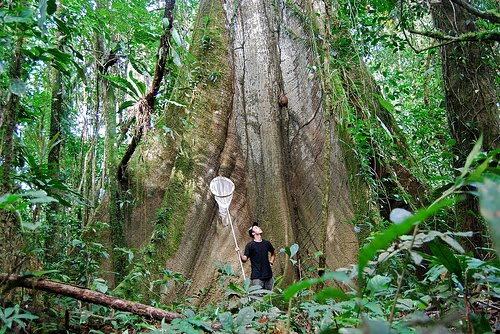Wednesday, 14 March, 2012
Today I travelled from Cusco, the imperial Inca city in the southern highlands of Peru, to Puerto Maldonado in the heart of the Peruvian Amazon. I’m here to scout locations for a trip later this year, in which I hope to gain an understanding of host-plant use by the clearwing butterflies that I’ve studied previously in Ecuador.
Along the way, from the small airplane window, I noticed a very long, wide swath of muddy pits and pools following the length of a meandering river in the Amazonian lowlands before Puerto Maldonado. Probably in denial – I had heard that illegal open pit gold mining was a problem in the area – I assumed it was a flooded river, or some sort of natural geological formation at any rate. No way was this a gold mine, many kilometers in length and probably several in width – the scale of the thing was just too massive.
Google Earth screenshot of Madre de Dios province. Puerto Maldonado is at the right, the brown spot on the bottom left is a gigantic area of open pit gold mines. You can see it from outer space (i.e. zoomed out much further).
When I arrived at the tiny jungle airstrip in Puerto, as it’s called, I asked a local man what we had seen from the plane. He confirmed that it was indeed illegal mining.
I was absolutely shocked.
---
I asked the man if I could share a mototaxi – a small motorcycle-taxi hybrid – to town to find a hotel, and as we left the airport we were informed that the road into town was blocked by protesters. No rickshaws were waiting outside, so we set off walking, not heeding the warning.
Eventually a mototaxi passed and we negotiated with the reluctant driver to take us to town. Sure enough, after a kilometer or so the road was blocked by a pile of trees and concrete rubble. A couple of detours similarly resulted in dead-ends. Two men with motorcycles offered to take us a bit further, and they took us as far as they could – we were stopped by a massive protest.
A block ahead of the protest were police in riot gear. There were lots of gunshots. Suddenly, a helicopter approached, flying overhead, and circled around an area of a few blocks, dropping canisters of teargas into the crowds. People were running, I heard someone shouting a protester had been shot and killed.
All this time, I had no idea what to do – I had no place to go, no idea where I was going anyway, and to make matters worse I stuck out like a giant sore thumb. This day was going from bad to worse.
I decided to hang out for a while and wait until things calmed down a bit – that didn’t really happen, so I decided to just walk around the main street, and by the grace of all that is good I found the one hotel – the one building in fact – that was open. Relieved and safely inside, I immediately began to ask what was happening.
Helicopter circling over Puerto Maldonado as it drops tear gas canisters on protesters
The government recently launched a crackdown on illegal gold-mining in the area. Apparently, the people protesting in the streets were upset because they felt the government was taking no steps to make the mining legal – they were simply confiscating the machines and fining people and putting them in prison.
While I sympathize with the miners – this place is quite poor, and people can make in a day what an average worker makes in nearly a month – the magnitude of the destruction is astonishing. There are something like 30,000 illegal miners in the Madre de Dios province, each of whom clears trees and then uses heavy pumps to blast open gigantic pits in the earth. Gold is then extracted from sludge using mercury, which is dumped into the local rivers by the ton. Clearly, this is as toxic as it is unsustainable, and the both rainforest and people’s health – not to mention future – is being devastated for very short term gain.
No news yet on the outcome of the protests, but I did hear they’re planning to continue through the week. This isn’t the first time something similar has happened, and the result each time has been several people dead and no resolution. What we can likely bet on is that the mining won’t stop quickly enough. Then again, other options probably won’t be available to people in this remote jungle outpost any time soon either.









